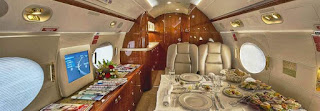https://centraljetcharter.com/learjet-36a.html
A maximum of 8 passengers can travel in the Learjet 36 cabin. The cabin is usually in a double club layout, with plenty of room for chairs to to swivel, recline, and track.
The Learjet 36 is the new and improved version of the Lear 35 and can fly 1,530 miles (1,330 nautical miles) nonstop.
The real strengths of the Learjet 36 are its range, takeoff, and cruise capabilities. Two Honeywell TFE731-2-2B engines provide 3,500 pounds of thrust, allowing the Lear 36 to take off in 4,972 feet.
The maximum take off weight is pretty high as well at 18,300 pounds. Components of the TFE731-2-2B engines are used in much higher-performing jets, adding to the 36’s credentials.
The engine’s pressure compressors were taken from the Garret 660-series engine, which is used on 747s.
Their turbine components come from DC-10s, and the high-pressure impellers are modified versions of the ones used in the TPE 331 and T76 engines.
A maximum of 8 passengers can travel in the Learjet 36 cabin. The cabin is usually in a double club layout, with plenty of room for chairs to to swivel, recline, and track.
The Learjet 36 is the new and improved version of the Lear 35 and can fly 1,530 miles (1,330 nautical miles) nonstop.
The real strengths of the Learjet 36 are its range, takeoff, and cruise capabilities. Two Honeywell TFE731-2-2B engines provide 3,500 pounds of thrust, allowing the Lear 36 to take off in 4,972 feet.
The maximum take off weight is pretty high as well at 18,300 pounds. Components of the TFE731-2-2B engines are used in much higher-performing jets, adding to the 36’s credentials.
The engine’s pressure compressors were taken from the Garret 660-series engine, which is used on 747s.
Their turbine components come from DC-10s, and the high-pressure impellers are modified versions of the ones used in the TPE 331 and T76 engines.




Comments
Post a Comment